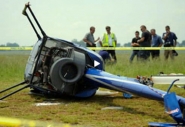Preliminary Report: Brazilian Jet Overruns Runway
Cessna Citation CJ3, São Paulo (SBSP), Brazil, Nov. 11, 2012–The captain of a Cessna Citation CJ3 was seriously injured as the aircraft ran off the end of 4,700-foot-long Runway 35R at São Paulo Congonhas Airport. The first officer and lone passenger sustained only minor injuries. Witnesses said the aircraft bounced high into the air a number of times before coming to rest against an airport fence, reportedly after the brakes failed. There was no post-crash fire.
Hourly weather just before the overrun reported relatively clear skies and good visibility, with surface wind from the northwest at nine knots. Weather reported not long after the accident confirmed a major wind shift to southerly at 13 knots with approaching thunderstorms.
Preliminary Report: Pasadena Police Helicopters Mesh Rotors
Bell OH-58s, Pasadena Police Benedict Heliport, Altadena, Calif., Nov. 17, 2012–A pair of police helicopters was destroyed late in the afternoon when the main rotor blades of the Vietnam-era Bell OH-58s collided as one was landing and the other was preparing to take off. One helicopter rolled onto its side. All six people aboard both helicopters were treated for minor injuries at a nearby hospital and released. One helicopter had been assigned the annual USC–UCLA football game, while the other was on routine patrol.
Preliminary Report: Turboprop Crashes in Remote Region of Canada
Cessna 208B Caravan, Snow Lake, Manitoba (CJE4), Canada, Nov. 18, 2012–The Grand Caravan was destroyed when it crashed shortly after takeoff from Snow Lake Airport in Manitoba, 360 miles north of Winnipeg, at approximately 10 a.m. local time. The pilot was killed and the eight passengers were seriously injured. The crash occurred in a remote region east of the airport, and authorities were notified of the event after one of the injured passengers used a cellphone to call for help.
Preliminary Report: Atlanta Police Helicopter Strikes Wires
Hughes OH-6A, Atlanta, Ga., Nov. 3, 2012–Two Atlanta police officers died when their Hughes OH-6A crashed after striking wires near the top of a 42-foot power pole. A post-crash fire destroyed the fuselage and cabin. The helicopter had departed Atlanta Hartsfield Jackson International Airport in support of a local search for a missing girl in night visual conditions about 20 minutes before the accident.
Preliminary Report: Customs Jet Destroyed in Ground Accident
Cessna 550 Citation II, Greenwood County Airport (KGRD), S.C.–A Cessna Citation on a Part 91 maintenance flight was destroyed when it struck a deer while making a daytime landing on Runway 9. The deer appeared from the nearby woods and attempted to cross the active runway, colliding with the aircraft’s left wing. The PIC managed to keep the aircraft on the runway, but the collision ruptured the left wing fuel tank and the ensuing fire consumed all the aircraft except for the nose. The two crewmembers escaped unharmed.
Preliminary Report: Powerline Patrol Accident Claims Two
MD Helicopters MD500 (369), Corning N.Y., Nov. 15, 2012–An MD500 owned and operated by Gettysburg, Pa.-based Haverfield Aviation crashed about midday next to the Chemung River in downtown Corning, N.Y., after becoming entangled in power lines. The helicopter was conducting a Part 91 routine observation mission at the time of the accident. The pilot and an observer were killed when the helicopter hit the ground and exploded. The tail rotor assembly separated and the cabin came to rest inverted. A witness reported, “The helicopter appeared [to be flying] below the highest tower, shortly before it struck power lines that extended to the south, perpendicular to the helicopter’s flight path.”
Preliminary Report: Customs Helicopter Damaged in Arizona Accident
Eurocopter AS350, near Newfield, Ariz., Nov. 23, 2012–An AS350 registered to U.S. Customs and Border Patrol operating in visual conditions was substantially damaged following loss of control near Newfield, Ariz. Neither the pilot nor the sole passenger aboard was injured. They had landed for a lunch break after two hours of flying from Davis Monthan AFB. The pilot said the helicopter’s engine was running at 100-percent with flat pitch, when he secured the collective in the full bottom position and frictioned the cyclic. As the pilot reached for his lunch, the helicopter became light on its forward skids and began to pitch up. The pilot tried to correct, but the machine began to oscillate vertically. He attempted to lift off to regain stability but an uncommanded downward change in pitch quickly became an uncontrollable left yaw. The pilot said he had little tail rotor authority but managed to land the aircraft. After securing the helicopter, the pilot found that both tail rotor blades had separated and that the aft section of the tail boom was severed.
Preliminary Report: Worker Killed in Part 133 Accident
MD Helicopters MD500 (369D), near Childress, Texas, Nov. 27, 2012–At about 4 p.m. local time the MD500, operated by Brim Equipment Leasing (dba Brim Aviation) under Part 133, experienced a loss of engine power during powerline construction work. The helicopter hit terrain during a forced landing near the transmission-tower construction site. The commercial pilot received minor injuries, but the worker attached to a long line on the helicopter was killed. The helicopter received substantial damage to the main rotor, fuselage and tailboom.
Preliminary Report: Pilot Lands Turboprop on Frozen Alaskan Lake
Cessna Caravan 208B, Mekoryuk (KMYU), Alaska, Dec. 3, 2012–The pilot of a PT6-powered Cessna 208B Caravan operated by Hageland Aviation Services, dba ERA Alaska of Anchorage, said the aircraft’s engine began to run rough and lose power shortly after takeoff from Mekoryuk. The second-in-command of the Part 135 scheduled airline flight was operating the controls at the time but relinquished them to the PIC, who attempted an unsuccessful engine restart. The pilot chose to put the airplane down on a frozen lake, and although the right wing and fuselage were substantially damaged in the process there was just one minor injury among the nine people aboard.
Final Report: Twin-engine Helicopter Damaged During Winch Operations
Bell 222B, Gulf of Mexico, April 8, 2009–The NTSB blamed pilot error for a Bell 222 striking an obstruction on the deck of a ship during a late-afternoon landing in the Gulf of Mexico off the Texas coast. The pilot and the four passengers were not injured, and there were no injuries to anyone on the ship.
The Bell 222, owned by Central Helicopter Service of Houston and operated under Part 135, departed Houston Hobby Airport (KHOU) bound for a ship at anchor 71 nm southeast of Galveston, Texas.
The pilot estimated the surface wind was variable from 250 degrees to 305 degrees at 15 knots as he approached the 870-foot-long Norwegian motor tanker Wilana. The pilot was directed in by ship’s personnel to an area labeled as “winch only,” when the helicopter’s tail rotor struck a valve assembly protruding from the ship’s deck. The helicopter yawed approximately 60 degrees to the right, then struck the ship’s side rail with its tail, and came to rest upright on the deck.
The pilot and four passengers exited the helicopter normally through the doors on the right side of the helicopter after shutdown procedures were complete.
The helicopter’s fuselage, tail boom, horizontal stabilizer, tail-rotor blades, tail-rotor hub and tail-rotor gearbox were substantially damaged. The pilot’s statement later recommended, “Pilots need to use extreme caution when conducting confined-area shipboard landings. Be especially vigilant for obstacles that are painted the same color as the deck…”
Final Report: Turboprop Pilot Became Incapacitated
Beechcraft King Air B200, Southwest Florida International Airport (KRSW), Fla., April 12, 2009–The pilot of a King Air B200 became incapacitated about 45 minutes after departure on an IFR flight plan from Marco Island (KMKY), Fla. The aircraft, registered to White Equipment Leasing, later landed uneventfully at Fort Meyers Airport when the owner, a certified private pilot, assumed command. The aircraft was flying in visual conditions on autopilot at the time the pilot lost consciousness. Neither the aircraft owner nor any of the three additional people aboard was injured. The pilot, however, was pronounced dead upon arrival at Fort Myers.
The owner told investigators the pilot assisted with loading baggage and did not mention any physical problems. The owner, who was sitting in the right seat, said the pilot ran through the after-takeoff checklist normally, but that while flying between 5,000 and 6,000 feet msl, put his head down with both hands at his sides. The owner was unable to get the pilot’s attention.
Miami Center’s ATC tapes revealed the controller initially cleared the King Air to climb on a northerly heading to 14,000 feet msl. The pilot did not respond, and approximately 20 seconds later the owner declared an emergency, advising the controller of the pilot’s condition and the need to speak with someone familiar with the aircraft. Another Miami ARTCC controller talked the owner through the process of disengaging the autopilot, descending and changing headings. ATC communications were then transferred to Fort Myers Approach Control, where another controller provided the owner with additional information to operate the landing gear, flaps, power levers and proper airspeed settings. The flight was vectored for a 15-mile final approach for Runway 6 at RSW, and the airplane landed uneventfully. The owner taxied off the runway, shut down the engines and was met by medical personnel.
The pilot’s most recent medical application, dated Nov. 20, 2008, indicates “Yes” in response to the question, “Do you currently use any medication?” and notes clopidogrel (blood thinner), aspirin, amlodipine (anti-hypertensive) and simvastatin (cholesterol lowering). The application notes “Yes” to “heart or vascular trouble” and to “high or low blood pressure.” The NTSB medical officer extracted the pilot’s cause of death from the local coroner’s report: hypertensive and arteriosclerotic cardiovascular disease.
January 2, 2013, 4:25 AM




